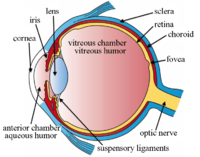
Photo from wikipedia
Background Acute post-cataract endophthalmitis (APE) is a rare complication potentially causing irreversible visual loss. A 10-year study of APE was conducted to determine its incidence, microbiological spectra and antibiotic resistance… Click to show full abstract
Background Acute post-cataract endophthalmitis (APE) is a rare complication potentially causing irreversible visual loss. A 10-year study of APE was conducted to determine its incidence, microbiological spectra and antibiotic resistance profile of APE-related pathogens at a major tertiary referral center in Brazil. Methods APE cases reported between January 2010 and December 2019 were included. Phacoemulsification and extracapsular cataract techniques were eligible; combined procedures, traumatic and congenital cataract were excluded. Vitreous samples were cultured and antimicrobial resistance was compared for the periods of 2010–2014 and 2015–2019. The results were analyzed with Fisher’s exact test. Results Our sample consisted of 40,491 cataract surgeries and 51 (0.126%) APE cases. Culture was positive in 35 cases (71.4%), of which 31 (88.6%) Gram-positive, 3 (8.6%) Gram-negative, and 1 (2.9%) fungal. The most frequently isolated organism was Staphylococcus epidermidis (n = 17/35, 48.6%), followed by Staphylococcus aureus (n = 4/35, 11.4%). From 2010–2014 to 2015–2019, antimicrobial resistance increased against moxifloxacin (11.1–54.5%, p = 0.07), ciprofloxacin (54.5–72.7%, p = 0.659) and oxacillin (66.7–93.3%, p = 0.13). Conclusions The observed incidence and microbial spectra were compatible with previous studies. A trend towards growing moxifloxacin and ciprofloxacin resistance was observed. Surveillance remains crucial to prevent treatment failure from antimicrobial resistance.
Journal Title: International Journal of Retina and Vitreous
Year Published: 2021
Link to full text (if available)
Share on Social Media: Sign Up to like & get
recommendations!